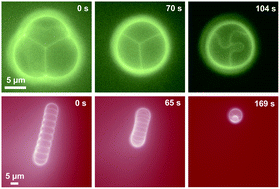Dynamic morphologies of microscale droplet interface bilayers†
Abstract
Droplet interface bilayers (DIBs) are a powerful platform for studying the dynamics of synthetic cellular membranes; however, very little has been done to exploit the unique dynamical features of DIBs. Here, we generate microscale droplet interface bilayers (μDIBs) by bringing together femtoliter-volume water droplets in a microfluidic oil channel, and characterize morphological changes of the μDIBs as the droplets shrink due to evaporation. By varying the initial conditions of the system, we identify three distinct classes of dynamic morphology. (1) Buckling and fission: when forming μDIBs using the lipid-out method (lipids in oil phase), lipids in the shrinking monolayers continually pair together and slide into the bilayer to conserve their mass. As the bilayer continues to grow, it becomes confined, buckles, and eventually fissions one or more vesicles. (2) Uniform shrinking: when using the lipid-in method (lipids in water phase) to form μDIBs, lipids uniformly transfer from the monolayers and bilayer into vesicles contained inside the water droplets. (3) Stretching and unzipping: finally, when the droplets are pinned to the wall(s) of the microfluidic channel, the droplets become stretched during evaporation, culminating in the unzipping of the bilayer and droplet separation. These findings offer a better understanding of the dynamics of coupled lipid interfaces.


 Please wait while we load your content...
Please wait while we load your content...